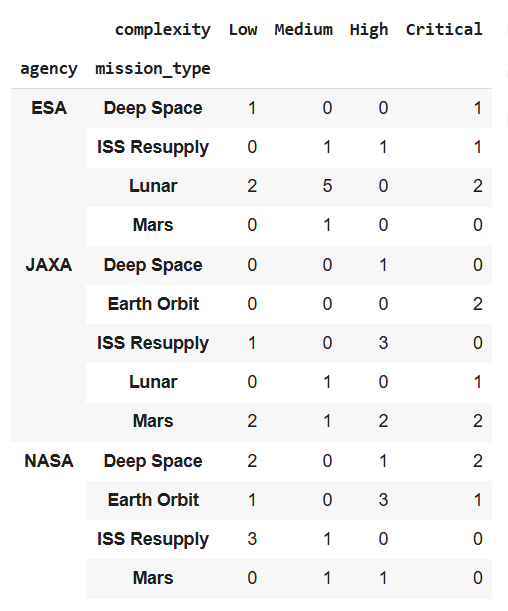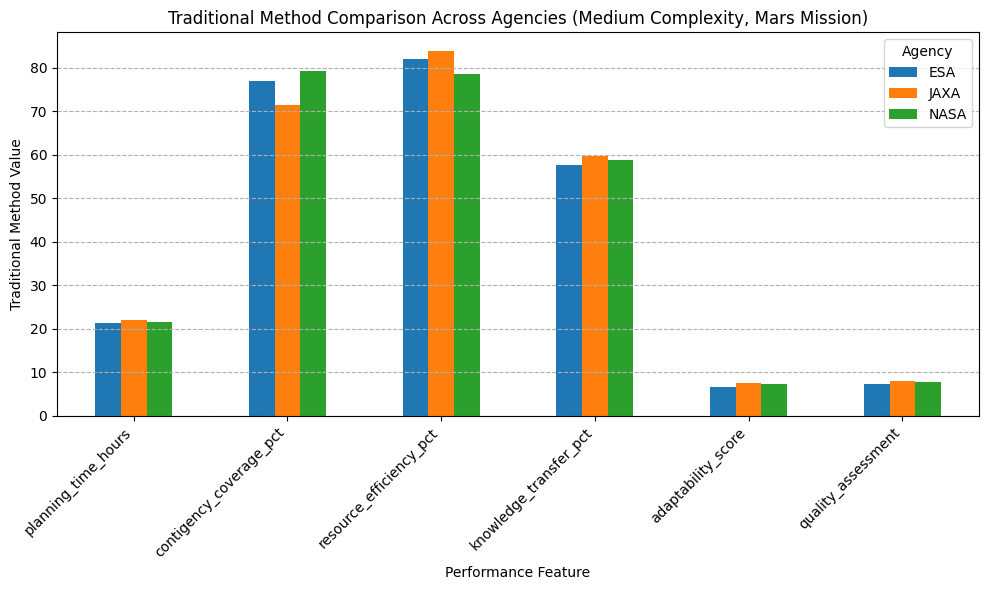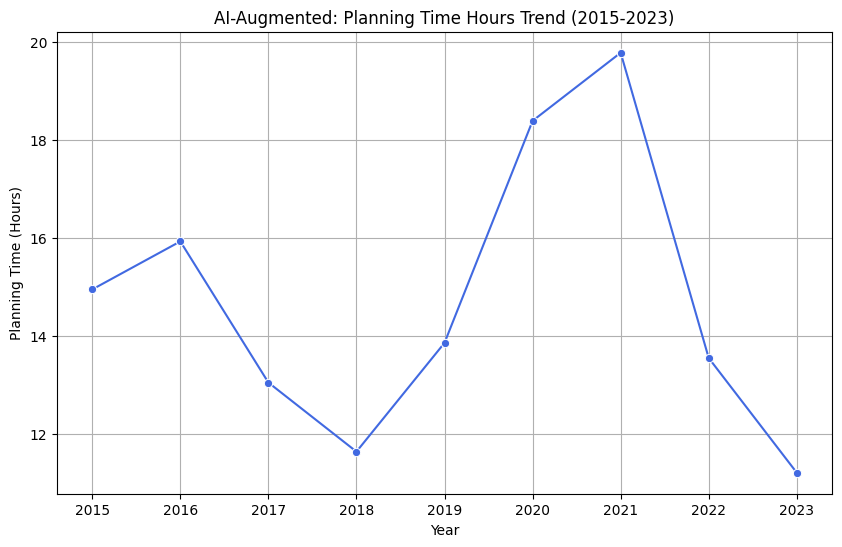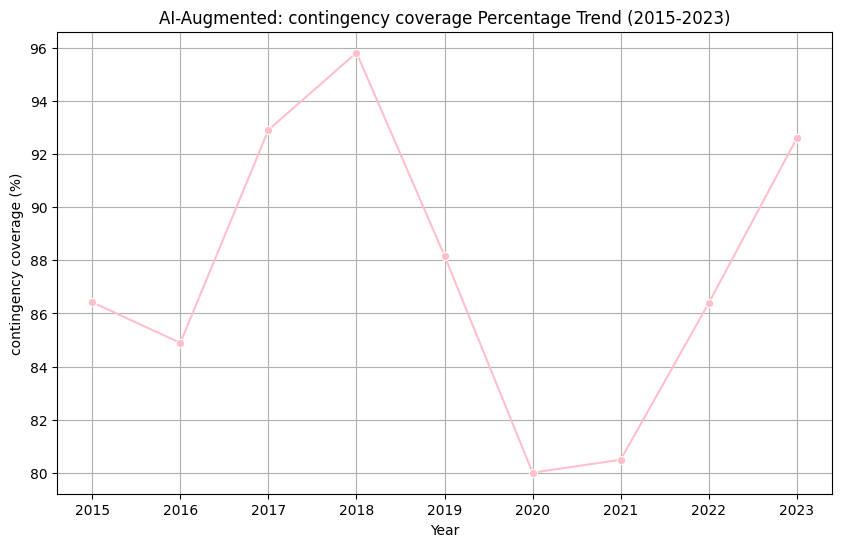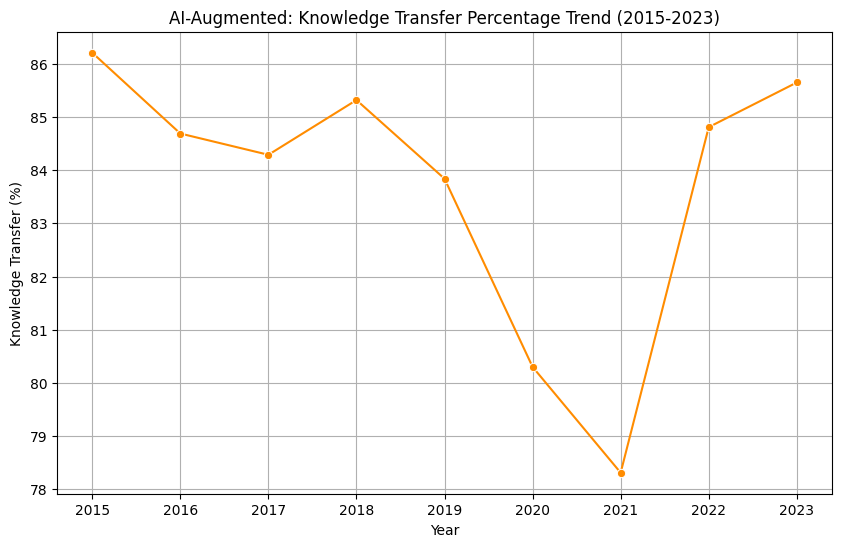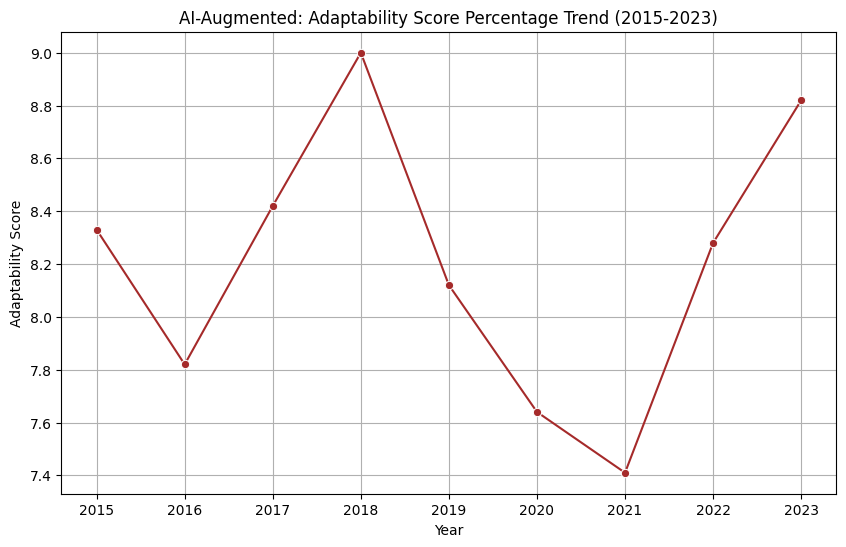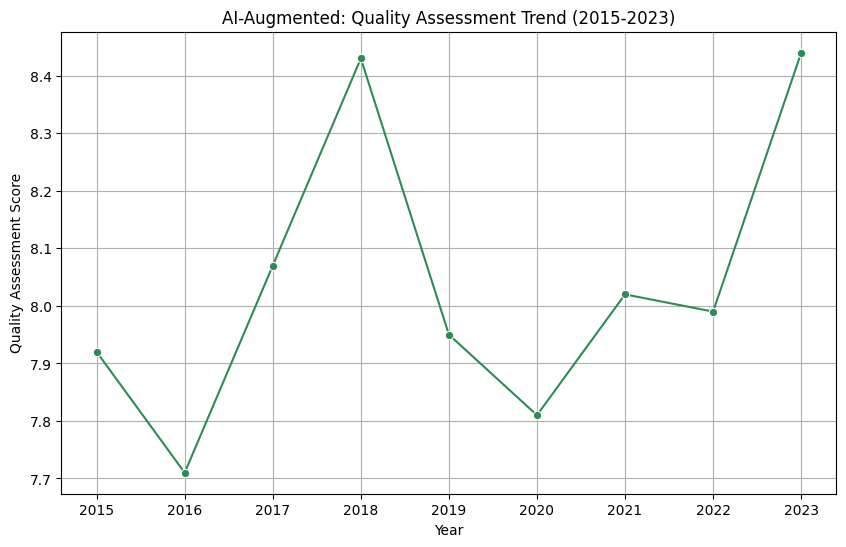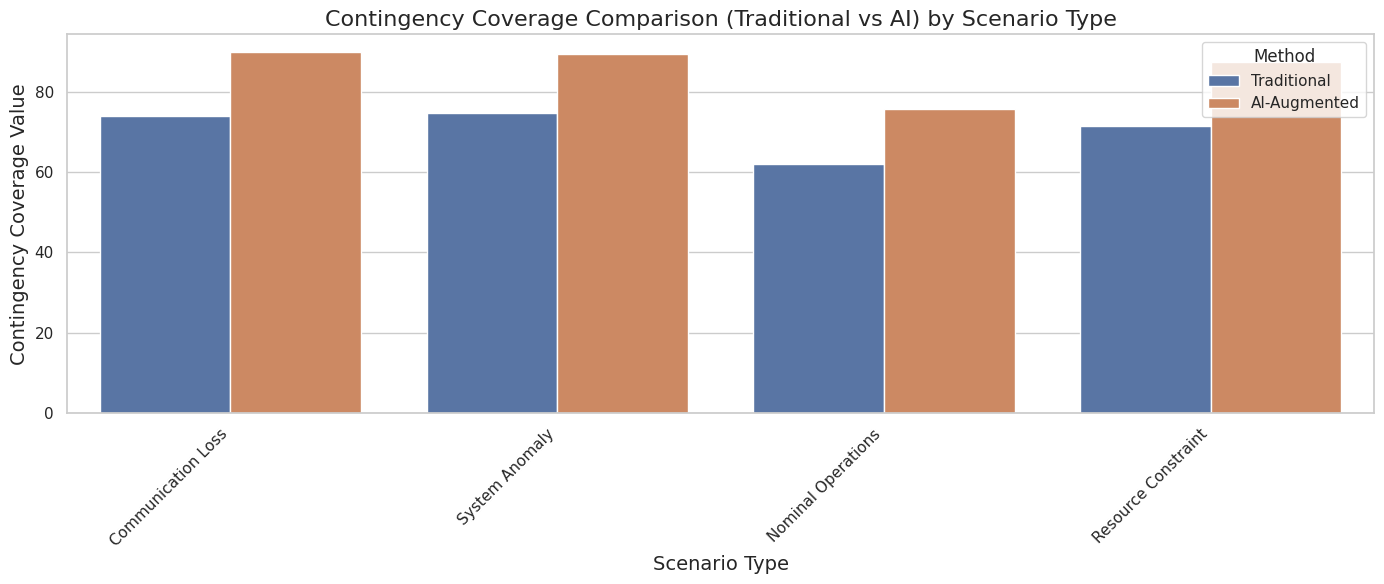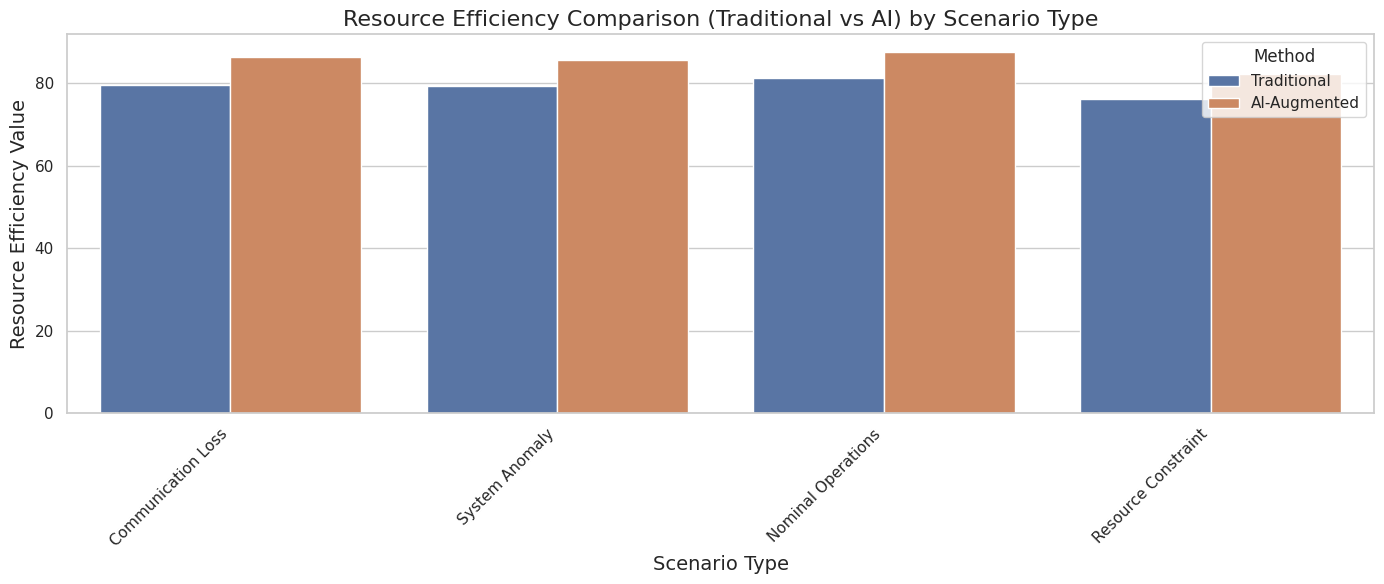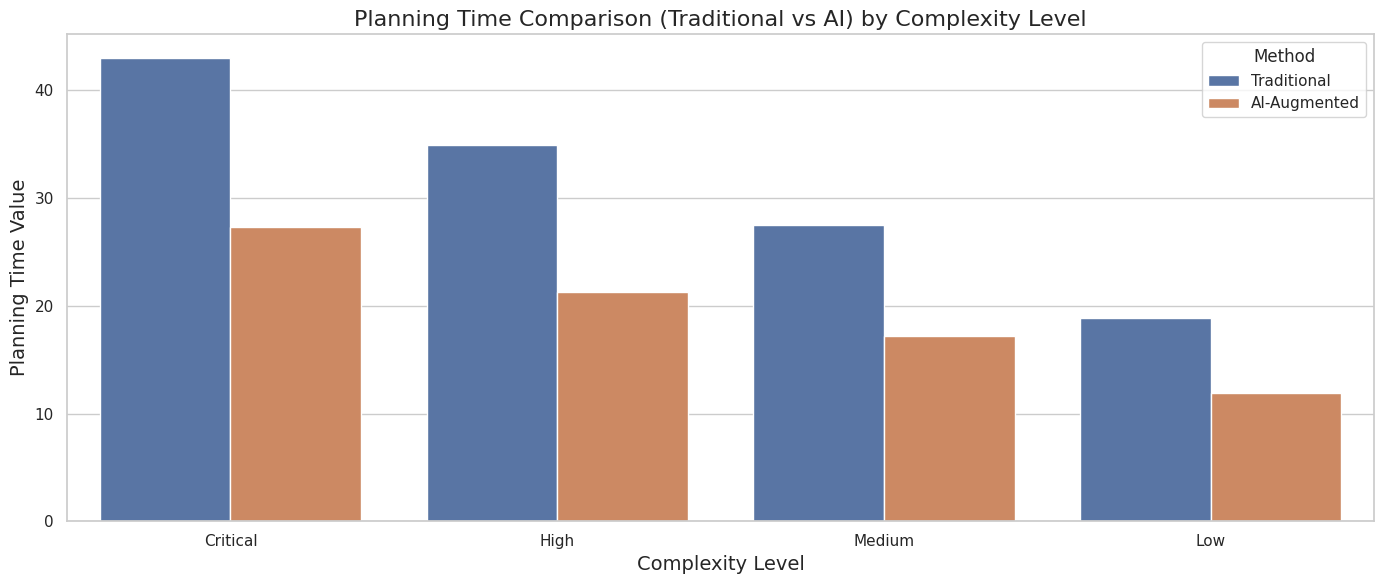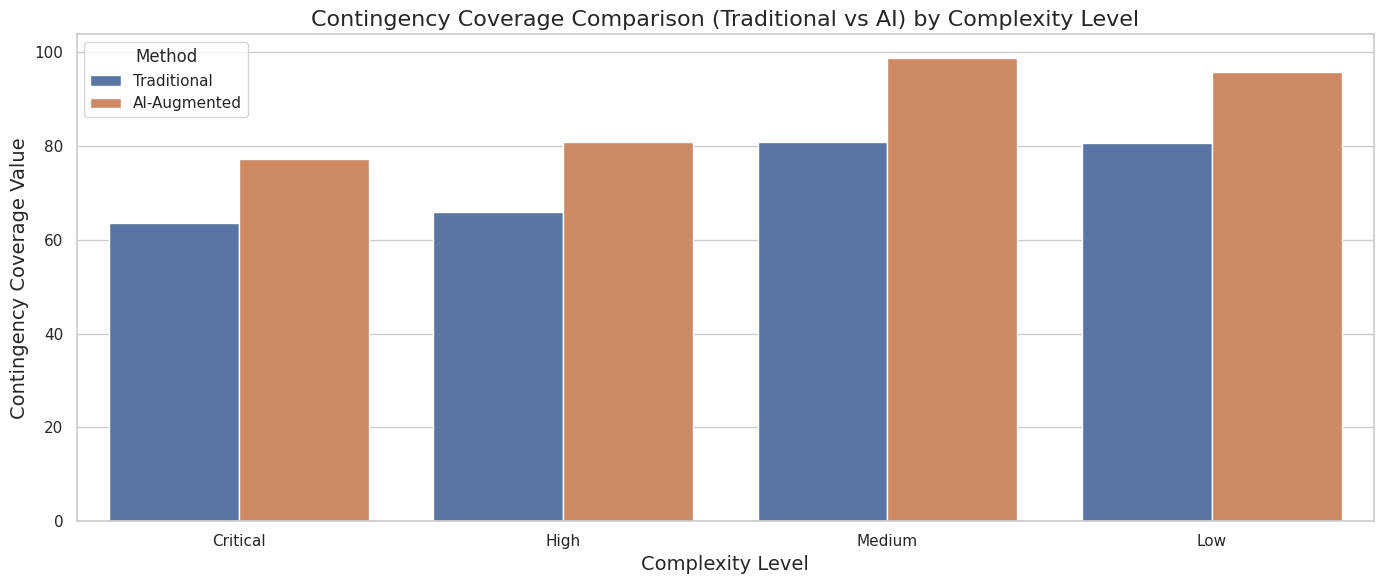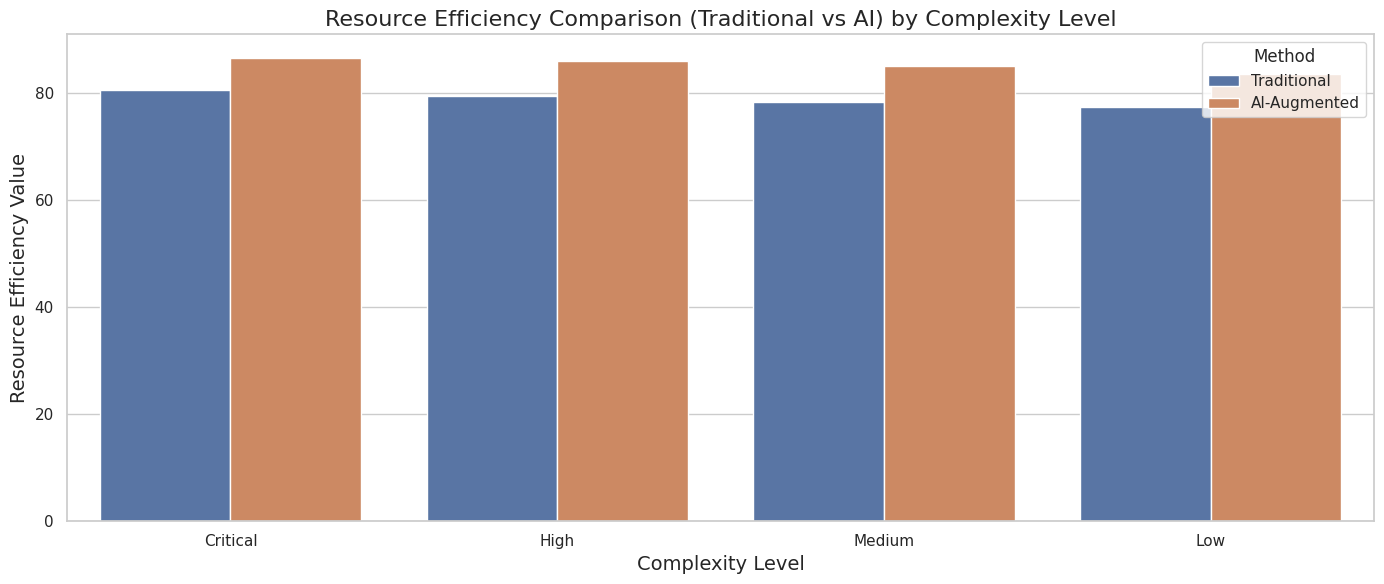
AI isn’t the silver bullet for space mission planning — its true value emerges only when paired with human intuition, strategic collaboration, and adaptive resilience.
Optimizing Space Mission Planning: Traditional Methods vs AI-Augmented Approaches
- May 9, 2025
- By Sagarika Chikhale
This project focuses on analyzing the effectiveness of AI-augmented mission planning methods across various space agencies and mission complexities. The analysis compares traditional and AI-augmented planning methods in terms of mission planning time, knowledge transfer efficiency, and contingency coverage. Key areas explored include the evolution of AI-enhanced planning metrics, the differences in AI adoption between NASA, ESA, and JAXA, and the varying impact of AI across mission scenarios. By identifying strengths and areas for improvement, this project aims to provide actionable insights to optimize the integration of AI for future space missions, ensuring more efficient, resilient, and adaptive planning strategies.
How Effectively Does AI-Augmented Planning Enhance Mission Planning Time, Knowledge Transfer Efficiency, and Contingency Coverage Across Different Complexity Levels, Mission Sequences, and Mission Phases?
This analysis demonstrates how AI-augmented planning improves mission speed, knowledge continuity, and contingency preparation. It highlights where AI adds maximum value across mission complexities and phases, enabling space agencies to better manage risks, optimize operations, and enhance the reliability of critical missions.
The following table presents a high-level summary comparison of planning time between Traditional and AI-Augmented methods, grouped by complexity levels (Low, Medium, High, Critical). From the analysis, it is evident that AI significantly reduces mission planning time across all complexities, with the percentage improvement increasing as mission complexity rises. This trend indicates that AI-Augmented method becomes more beneficial as missions grow in complexity, suggesting that for highly critical missions such as Mars expeditions or Deep Space explorations, AI-driven planning can notably accelerate mission readiness, reduce operational delays, and minimize cost overruns.

The high-level summary comparison of knowledge transfer efficiency between Traditional and AI-Augmented methods, grouped by mission sequences (1 to 5) shown in table. The analysis highlights that AI consistently improves knowledge transfer efficiency across all mission sequences. This indicates that AI tools help preserve, retain, and transfer critical operational knowledge more effectively over time, which is particularly crucial in extended mission campaigns like multi-stage Mars colonization efforts, where continuity of expertise and learnings across missions is essential for sustained success.
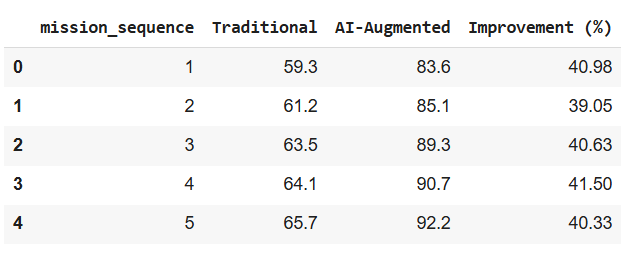
Moreover, the following analysis provides a high-level summary comparison of contingency coverage between Traditional and AI-Augmented methods, grouped by mission phases (Launch, Transit, Orbital, Surface, Return). From the analysis, it is observed that while the improvement is moderate in early mission phases (11% in Launch, 17% in Transit), it becomes significantly higher in later phases (29.40% in Surface and 29.02% in Return). This finding suggests that AI-augmented planning method can be advantages in later, more unpredictable stages of the mission, where the risk environment is more dynamic and complex. Thus, focusing AI integration during mid-to-late mission phases can drastically enhance mission safety and robustness.
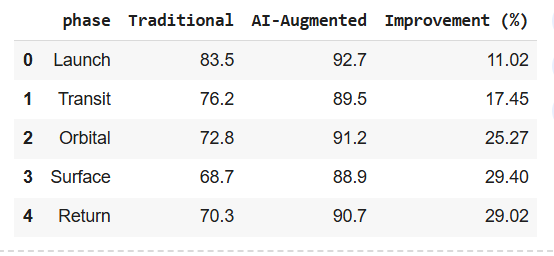
Through this detailed analysis, it becomes clear that AI-Augmented Planning methods substantially improve mission planning quality across critical dimensions such as speeding up complex decision-making, enhancing knowledge continuity, and strengthening mission resilience during risky phases. By leveraging AI, space agencies can make mission planning faster, safer, and more reliable, ultimately paving the way for more ambitious and sustainable space exploration endeavors.
How Do NASA, ESA, and JAXA Differ in the Effectiveness of AI-Augmented Mission Planning Under Similar Mission Conditions (Medium Complexity and Mars Missions)?
This analysis reveals how NASA, ESA, and JAXA vary in AI-augmented mission planning effectiveness under similar conditions. By comparing their strengths and improvements, it highlights how organizational readiness, technological maturity, and operational focus influence AI’s impact, guiding agencies on optimizing AI integration for mission success.
To understand the differences in AI-augmented planning effectiveness among NASA, ESA, and JAXA, a focused comparison was conducted. This analysis was carefully limited to missions with Medium Complexity and Mars as the mission type, ensuring a fair basis for comparison across the three agencies. The controlled conditions helped eliminate variability arising from differences in mission type or complexity, offering a more accurate picture of each agency’s planning practices and their response to AI integration.
Initial examination of mission interests showed distinct agency priorities, with ESA favoring Lunar missions, JAXA showing a greater focus on Mars, and NASA concentrating on Deep Space and Earth Orbit missions. Complexity analysis further revealed that NASA and ESA engaged more frequently in low and medium complexity missions, whereas JAXA’s missions leaned towards higher and critical complexity. This backdrop provided important context for interpreting the agencies’ performance under AI-augmented methods.
A comparative evaluation based on Medium Complexity Mars Missions highlighted that under traditional methods, JAXA led across several key planning areas including planning time, resource efficiency, knowledge transfer, adaptability, and quality assessment, although it lagged slightly in contingency coverage compared to NASA. However, with the implementation of AI-augmented planning, all three agencies demonstrated significant improvements across planning metrics. Notably, ESA exhibited the highest percentage improvement relative to its traditional baseline, followed by NASA and then JAXA. Despite a time gap between missions (ESA and NASA missions in 2018 vs. JAXA’s mission in 2023), the similarity in improvement percentages suggests that ESA and NASA had already integrated highly capable AI systems years earlier, raising intriguing considerations about the technological maturity across agencies.
Further, a detailed phase-wise comparison was performed, breaking down planning performance across the five key mission phases: Launch, Transit, Orbit, Surface, and Return. Analysis of planning time revealed that NASA traditionally managed lower planning times compared to JAXA and ESA across most phases. Even after AI augmentation, NASA maintained a slight advantage in planning time efficiency, although all agencies showed noticeable improvements and the gap among them narrowed.

Similarly, evaluation of contingency coverage across mission phases showed that NASA historically maintained stronger contingency plans compared to the others. Post AI-augmentation, contingency planning improved for all three agencies, but NASA and JAXA generally performed better than ESA in most mission phases, suggesting that pre-existing operational strengths also influence how well agencies leverage AI enhancements.

Resource management capabilities were assessed through a breakdown of resource efficiency across different critical resource types such as power, propellant, bandwidth, and crew time. Here, NASA had the advantage under traditional methods, displaying strong efficiency across most resource types. Following AI integration, JAXA demonstrated significant efficiency gains across multiple resource categories, indicating a swift and effective adoption of AI techniques for optimized resource planning.

Overall, the comparative analysis reflects that while each agency benefited from AI-augmented planning, the extent of improvement and the areas of strength varied based on their original baseline capabilities. ESA made the most relative gains by maximizing the benefits of AI integration, NASA maintained consistent excellence particularly in time-critical and contingency aspects, and JAXA demonstrated strong resource optimization capabilities. These differences underscore that even under similar mission conditions, the effectiveness of AI-augmented planning can vary significantly depending on organizational strengths, technological readiness, and operational focus areas.
How Have Key Planning Metrics Evolved Over Time (2015–2023) with the Use of AI-Augmented Planning Methods?
This analysis shows that while AI-augmented planning improves mission performance over time, external disruptions like the COVID-19 pandemic can still affect outcomes. It highlights the need for operational resilience and adaptive strategies to maintain consistent AI effectiveness, even during unpredictable global or organizational challenges.
A time trend analysis was conducted to observe the evolution of mission planning performance from 2015 to 2023, focusing exclusively on missions utilizing AI-augmented planning. The study examined six critical planning metrics: planning time, contingency coverage, resource efficiency, knowledge transfer, adaptability score, and quality assessment.
Bringing together observations from Graphs, it is clear that certain performance patterns consistently emerged across all metrics. The years 2023 and 2018 stood out for achieving the best performance, demonstrating lower planning times, higher contingency coverage, better resource efficiency, stronger knowledge transfer, greater adaptability, and higher quality assessment, highlighting the effective utilization of AI-augmented planning technologies during these years. On the contrary, 2020 and 2021 were identified as periods of relatively weaker performance across almost all planning areas, with longer planning times, lower contingency coverage, decreased resource efficiency, weaker knowledge transfer, reduced adaptability, and lower quality assessment scores. These years may be suggesting that external disruptions or internal inefficiencies temporarily reduced the effectiveness of mission planning even with AI support. Other years like 2017 and 2015 also showed some strong results in specific metrics, but not consistently across all areas.
Observing the overall trend, AI-augmented performance first peaked in 2018, then declined during 2020 and 2021, before improving again by 2023. This dip in the middle years could realistically be attributed to several factors such as the global COVID-19 pandemic during started in 2019 and affecting the 2020-2021 years, this may have severely disrupted mission operations, caused delays, reduced availability of skilled personnel, or impacted training and resource management, all of which could have weakened the ability to fully leverage AI-based planning systems. Additionally, operational transitions, shifts in strategic priorities, or evolving mission complexities might have introduced temporary inconsistencies during these years. However, the clear rebound by 2023 shows that agencies were able to adapt, refine their AI-augmented methodologies, and achieve strong, reliable results once again. Therefore, the time-trend analysis not only reflects the maturing capabilities of AI-augmented mission planning but also emphasizes the importance of maintaining operational resilience and continuous optimization of AI integration to ensure sustained high performance even during unpredictable global or organizational disruptions.
How Does AI Improvement Vary by Scenario Type and Complexity Level in Simulations?
This analysis highlights how AI-augmented planning effectiveness shifts with different scenarios and complexity levels. Understanding these variations helps in realistically assessing AI’s strengths and limitations, ensuring its strategic deployment in conditions where it performs best and recognizing operational contexts where additional safeguards may be necessary.
To better understand the variations in AI-augmented planning effectiveness, simulation analyses were conducted across different scenario types (Nominal Operations, Communication Loss, System Anomaly, and Resource Constraint) and complexity levels (Low, Medium, High, and Critical). The focus was on three key planning areas: planning time, contingency coverage, and resource efficiency.
From the analysis of scenario types, it was observed that both traditional and AI-augmented methods performed better under the Communication Loss scenario. Specifically, lower planning time, higher contingency coverage, and stronger resource efficiency were achieved in this scenario compared to others. On the other hand, Nominal Operations scenario showed relatively poor results for planning time and contingency coverage, indicating higher time taken and lower readiness to handle contingencies. Additionally, in terms of resource efficiency, the Resource Constraint scenario obviously exhibited the weakest performance, showing that optimizing resources became particularly challenging under restricted conditions.
Similarly, the analysis based on scenario complexity levels revealed that both traditional and AI-augmented approaches consistently delivered better planning time and contingency coverage results in Low Complexity scenarios. Lower complexity led to faster planning and stronger contingency preparation. However, when it came to resource efficiency, Critical Complexity scenarios unexpectedly showed better performance, suggesting that under highly critical conditions, resource management becomes more optimized, possibly due to stricter mission requirements and careful planning. Conversely, Critical Complexity scenarios also showed poor results for planning time and contingency coverage, with longer times and weaker coverage, demonstrating the increasing challenges AI faces as mission difficulty intensifies. For resource efficiency, the lowest values were seen under Low Complexity scenarios, although the differences here were not as stark as in the other two areas.
Overall, the findings highlight that simulation scenario type and complexity level of scenarios play crucial roles in how effective AI-augmented planning can be. Performance varied considerably depending on operational context. Communication Loss scenarios consistently allowed better outcomes across planning metrics, while Nominal Operations and Resource Constraint scenarios presented specific challenges. In terms of complexity, AI systems handled low complexity well but struggled with high criticality in planning speed and contingency preparedness — although resource efficiency paradoxically improved under critical conditions. This analysis indicates that while AI-augmented methods generally enhance mission planning, their success is still strongly influenced by the operational environment and complexity they are applied to.
How Do Agency Leaders Across Roles, Agencies, and Experience Levels Perceive the Impact of AI in Mission Planning?
This analysis highlights how perceptions of AI improvements differ across roles, agencies, and experience levels. It helps identify which functions value AI most, where limitations are felt, and how professional maturity influences recognition of AI benefits, guiding more targeted and effective AI adoption strategies in mission planning.
To evaluate the perception of AI-augmented planning improvements, ratings were collected by data provider from agency leaders across different mission planning roles, space agencies, and experience levels.
The following Table analysis shows that among various roles, Risk Assessment Engineers perceived the most significant improvement with the adoption of AI, reflecting AI’s strong capabilities in enhancing risk analysis and decision-making processes. On the other hand, Resource Planning Specialists perceived the least improvement, indicating that AI’s contribution to resource planning tasks might still face limitations or require further refinement to meet expectations in this area.

Furthermore, experts from the JAXA agency (Japan Aerospace Exploration Agency) reported experiencing the highest perceived improvement with AI integration compared to other agencies. This suggests either a higher baseline of AI adoption effectiveness within JAXA or a more optimistic cultural approach towards leveraging AI technologies in mission planning.

Additionally, individuals with 15 years of professional experience reported perceiving the greatest improvement from AI solutions. This is an important observation, indicating that highly experienced professionals likely more familiar with traditional planning challenges — are able to recognize and appreciate the enhancements brought by AI more clearly than less experienced counterparts.

The findings show that AI’s impact is perceived differently depending on professional role, agency affiliation, and years of experience. Risk-oriented roles tend to appreciate AI’s strengths more than resource-focused ones. Certain agencies like JAXA appear to be more advanced or more positively aligned with AI integration. Moreover, deeper professional experience seems to allow experts to better understand and value the improvements brought by AI systems. Overall, this analysis underlines that perceptions of AI effectiveness are nuanced and shaped by the specific professional context and background of the individual.
Next Steps:
• Develop AI-Enhanced Resilient Mission Planning Frameworks for Uncertainty and Disruptions
The 2020–2021 performance dip highlights the vulnerability of AI-augmented mission planning systems to external disruptions like pandemics, geopolitical crises, and supply chain interruptions. To mitigate such risks in the future, space agencies should prioritize the development of AI-enhanced resilient mission planning frameworks that enable adaptive decision-making, flexible resource management, and continuity of operations even during unpredictable global events. These frameworks would focus on building AI systems that can adjust dynamically to disruptions and maintain mission planning effectiveness under uncertain and fluctuating conditions. To achieve this space agencies can integrate scenario-based training, real-time data feeds, and these systems should be stress-tested under simulated crisis conditions to ensure flexible decision-making and operational continuity in unpredictable environments.
• Implement Human-AI Hybrid Mission Planning for High-Risk and Complex Scenarios
While AI excels in optimizing complex processes and providing data-driven insights, it still struggles with scenarios involving high uncertainty, extreme risk, or unknown variables—key features of many space missions. To overcome this limitation, space agencies should develop hybrid human-AI planning models that leverage both the computational efficiency of AI and the intuitive, context-aware judgment of human experts. This approach ensures that AI systems assist in mission planning, but human decision-makers remain integral in handling the most complex, uncertain, or high-stakes scenarios where AI might lack sufficient context or insight.
• Set Up a Global AI Mission Planning Center for Space Agencies
Create a shared center where top space agencies like NASA, ESA, JAXA, and others can work together using AI to plan space missions. To achieve this space agencies can contribute funding, experts, and datasets to build a physical shared center. This center would help them test AI tools, share ideas, and build mission plans together. It would be a hands-on space where teams can design, simulate, and improve AI-based plans for real missions like going to the Moon, Mars, or deep space.
These steps will help space agencies by improving mission planning through AI-augmented and traditional hybrid methods. First, developing AI-enhanced resilient frameworks ensures adaptability during disruptions, maintaining mission effectiveness under uncertainty. Second, hybrid human-AI planning combines AI efficiency with human judgment, especially in high-risk, complex scenarios, ensuring safety and contextual decision-making. Lastly, the AI-driven cross-agency hub facilitates collaboration, allowing agencies to test AI tools and develop joint strategies, fostering innovation and operational synergy. Together, these approaches will enhance resilience, decision-making, and collaboration, optimizing mission planning for future space exploration.


